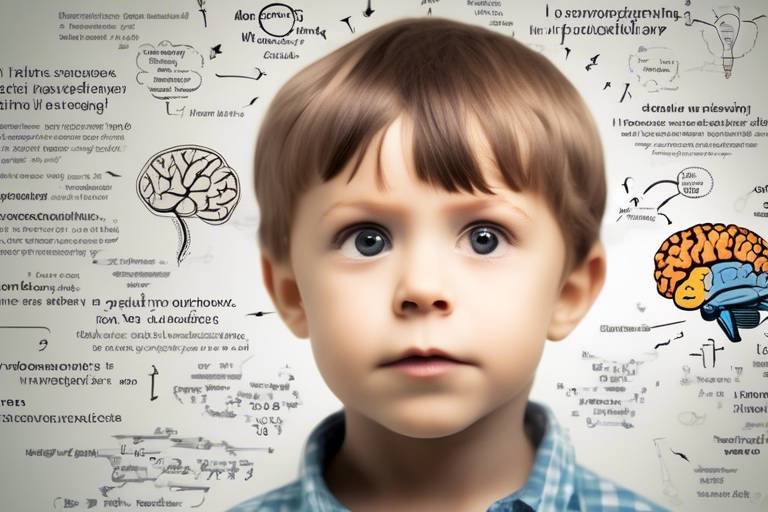How Neuroscience is Changing Our Understanding of Learning
In recent years, the intersection of neuroscience and education has sparked a revolution in how we perceive learning. Gone are the days when we viewed education solely as a process of rote memorization or passive absorption of information. Now, we are beginning to understand that learning is a complex interplay of brain functions, emotions, and social interactions. This article explores the transformative impact of neuroscience on educational practices, revealing how insights into brain function are reshaping our approaches to learning and teaching methodologies.
Imagine your brain as a vast city, with each neuron acting as a road connecting various districts. When we learn something new, it's like constructing new roads, enhancing the connectivity of this city. Neuroscience has illuminated the pathways of these connections, helping educators and learners alike understand that learning is not just about the accumulation of facts but about building a network of knowledge that can be accessed and utilized in various contexts.
One of the most significant revelations from neuroscience is the concept of neuroplasticity. This term refers to the brain's remarkable ability to reorganize itself by forming new neural connections throughout life. It’s like a tree that can grow new branches even after a storm has damaged its limbs. This adaptability influences learning at different stages of life, suggesting that no matter our age, we have the potential to learn and grow. Understanding this principle empowers educators to create learning environments that are not only supportive but also stimulating, encouraging students to take risks and explore new ideas.
As we delve deeper into this topic, it becomes clear that the implications of neuroscience extend far beyond the classroom. They challenge traditional teaching methods and inspire innovative approaches that cater to the diverse needs of learners. For instance, incorporating activities that promote neuroplasticity, such as collaborative learning, hands-on projects, and real-world problem-solving, can lead to enhanced engagement and retention. By embracing these strategies, educators can create a dynamic learning atmosphere that fosters curiosity and a love for learning.
However, it's essential to recognize that implementing these neuroscience-backed strategies in schools isn't without its challenges. Resistance to change, lack of resources, and varying levels of training among educators can create hurdles that must be addressed. Yet, the potential rewards of fostering an educational environment rooted in neuroscience are well worth the effort. As we continue to explore how our brains work in relation to learning, we can develop more effective teaching methodologies that not only enhance academic performance but also promote lifelong learning.
In conclusion, the integration of neuroscience into education is not just a trend; it's a fundamental shift in our understanding of how learning occurs. By appreciating the brain's incredible capabilities and the factors that influence learning, we can create more effective educational practices that cater to the diverse needs of all learners. The journey of learning is not merely about the destination but about the process itself, and neuroscience is guiding us to navigate this journey with greater insight and understanding.
- What is neuroplasticity? Neuroplasticity is the brain's ability to reorganize itself by forming new neural connections, allowing for learning and adaptation throughout life.
- How can teachers apply neuroscience in the classroom? Teachers can apply neuroscience by incorporating strategies that promote engagement, such as collaborative learning, hands-on activities, and real-world problem-solving.
- What role do emotions play in learning? Emotions significantly influence learning outcomes, impacting cognitive processes and retention. Emotional intelligence is crucial for creating a positive learning environment.
- How does stress affect learning? High levels of stress can hinder learning effectiveness, making it essential for educators to implement strategies to mitigate stress in educational settings.
- What motivates students to learn? Motivation is key to successful learning. Neuroscience informs our understanding of motivation, helping educators foster a more engaging and motivating atmosphere.

The Brain's Role in Learning
This article explores the transformative impact of neuroscience on educational practices, revealing how insights into brain function are reshaping our approaches to learning and teaching methodologies.
Understanding the brain's structure and functions is crucial for grasping how we learn. The brain is a complex organ, composed of billions of neurons that communicate through synapses, forming intricate networks that are essential for all cognitive processes. When we engage in learning, various regions of the brain collaborate to process information, store memories, and retrieve knowledge. Key areas involved in learning include the hippocampus, responsible for forming new memories; the prefrontal cortex, which manages higher-level thinking and decision-making; and the amygdala, which processes emotions and can significantly influence our learning experiences.
To illustrate this, consider the way you might learn to ride a bike. Initially, you rely heavily on your hippocampus to remember the steps involved. As you practice, your brain's motor cortex kicks in, allowing your body to perform the task almost automatically. This transition from conscious effort to automaticity showcases the brain's remarkable ability to adapt and optimize learning processes.
Moreover, the interplay between various brain regions highlights the importance of a holistic approach to education. Traditional teaching methods often emphasize rote memorization, which primarily engages the hippocampus. However, incorporating techniques that stimulate emotional engagement and critical thinking can activate the prefrontal cortex, leading to deeper understanding and retention of information.
The following table summarizes the key brain areas involved in learning and their respective functions:
| Brain Area | Function |
|---|---|
| Hippocampus | Formation of new memories |
| Prefrontal Cortex | Critical thinking and decision-making |
| Amygdala | Processing emotions and motivation |
| Cerebellum | Coordination and motor control |
In summary, understanding the brain's role in learning allows educators to tailor their teaching strategies to better align with how our brains naturally process information. By fostering an environment that engages multiple brain regions, we can enhance the learning experience, making it more effective and enjoyable for students.
- What is the most important part of the brain for learning? The hippocampus is crucial for forming new memories, while the prefrontal cortex is vital for higher-level thinking and decision-making.
- How does emotion affect learning? Emotions can significantly impact cognitive processes, influencing motivation and memory retention. Positive emotional states can enhance learning, while negative states can hinder it.
- Can learning change the brain? Yes, the brain is capable of neuroplasticity, meaning it can reorganize itself and form new neural connections based on learning experiences.

Neuroplasticity: The Brain's Adaptability
Neuroplasticity is one of the most fascinating aspects of neuroscience, shedding light on how our brains adapt and evolve throughout our lives. Imagine your brain as a flexible, ever-changing landscape rather than a rigid structure. Just like a river carves new paths through the land over time, our brains can form new neural connections in response to experiences, learning, and even injuries. This incredible ability to reorganize itself is what we call neuroplasticity, and it plays a pivotal role in how we learn and grow.
At the core of neuroplasticity is the brain's remarkable capacity to change its structure and function in response to various stimuli. Whether you're picking up a new skill, recovering from a brain injury, or simply adapting to a new environment, neuroplasticity is at work. It's like having a personal trainer for your brain, constantly reshaping itself based on the challenges and experiences you face.
Neuroplasticity can be classified into two main types: functional plasticity and structural plasticity. Functional plasticity refers to the brain's ability to move functions from damaged areas to undamaged areas. For instance, if someone suffers a stroke, other parts of their brain can sometimes take over the functions that were lost. On the other hand, structural plasticity involves the brain's ability to physically change its structure in response to learning and experience. This can include the growth of new neurons or the strengthening of synaptic connections.
Furthermore, neuroplasticity isn't just a phenomenon limited to childhood. While it's true that young brains exhibit a higher degree of plasticity, adults also possess this incredible capability. It's like the difference between a young tree that bends easily in the wind and an older tree that has grown strong and sturdy but can still adapt to new conditions. The brain continues to change and adapt throughout life, influenced by various factors such as environment, education, and personal experiences.
So, what does this mean for education? Understanding neuroplasticity opens up a world of possibilities for enhancing learning and teaching methodologies. By leveraging the brain's adaptability, educators can design learning experiences that not only engage students but also promote the formation of new neural pathways. Imagine a classroom where every lesson is tailored to stimulate and challenge students, allowing them to thrive and grow in their learning journeys.
To harness the power of neuroplasticity in educational settings, it's essential to create an environment that encourages exploration, creativity, and critical thinking. Here are a few strategies that can help:
- Encourage Active Learning: Engage students through hands-on activities, discussions, and collaborative projects that require them to think critically and creatively.
- Foster a Growth Mindset: Teach students that their abilities can improve with effort and practice, helping them embrace challenges as opportunities for growth.
- Incorporate Mindfulness Practices: Mindfulness can enhance focus and emotional regulation, creating a conducive learning environment that supports neuroplasticity.
In conclusion, neuroplasticity is a powerful reminder that learning is not a one-time event but a lifelong journey. By understanding how our brains can adapt and change, we can embrace new teaching methodologies that not only enhance learning outcomes but also empower students to become lifelong learners. The brain is a remarkable organ, and its ability to reshape itself is a testament to the incredible potential we all possess.

Implications for Education
The concept of neuroplasticity has profound implications for education, fundamentally reshaping how we approach teaching and learning. As we understand more about how the brain can change and adapt, it's clear that traditional methods may not always be the most effective. Educators are now encouraged to rethink their strategies, focusing on creating environments that promote brain development and foster a love for learning. This shift is not merely about incorporating new techniques; it’s about understanding that each student’s brain is unique and can be molded through experience.
One of the most exciting aspects of neuroplasticity is the idea that learning is not confined to early childhood. In fact, the brain continues to develop and adapt throughout life. This means that educational practices can be tailored to the age and developmental stage of the learner, ensuring that everyone, from toddlers to adults, can benefit from effective teaching methods. For instance, rather than relying solely on rote memorization, educators can employ interactive and experiential learning techniques that engage the brain in a more holistic manner.
Furthermore, understanding the brain’s adaptability opens the door to personalized learning. With insights from neuroscience, educators can identify individual learning styles and preferences, allowing for a more customized educational experience. Imagine a classroom where lessons are tailored to fit the unique ways in which each student learns best. This could involve:
- Utilizing technology to provide adaptive learning programs that adjust to student performance.
- Implementing collaborative projects that encourage peer-to-peer learning.
- Incorporating arts and creativity into the curriculum to stimulate different areas of the brain.
Additionally, fostering an environment that embraces failure as a part of the learning process can significantly enhance neuroplasticity. When students are encouraged to take risks and learn from their mistakes, they are more likely to develop resilience and a growth mindset. This approach not only supports brain development but also cultivates a culture of curiosity and innovation.
However, while the implications of neuroplasticity are promising, there are challenges to consider. Educators must be equipped with the right tools and training to implement these new methodologies effectively. Schools need to invest in professional development that focuses on the latest neuroscience research and its applications in the classroom. Moreover, creating a supportive environment that prioritizes mental health and emotional well-being is essential, as these factors are closely linked to learning outcomes.
In summary, embracing the principles of neuroplasticity in education can lead to more effective teaching strategies, personalized learning experiences, and a culture that values growth and adaptability. As we continue to explore the intricacies of the brain, the potential for transforming educational practices becomes increasingly evident.
Q1: What is neuroplasticity?
Neuroplasticity is the brain's ability to reorganize itself by forming new neural connections throughout life. This adaptability allows for learning and recovery from injuries.
Q2: How can neuroplasticity be applied in education?
Educators can apply neuroplasticity by using interactive teaching methods, personalizing learning experiences, and creating environments that encourage risk-taking and resilience.
Q3: Are there specific strategies to enhance neuroplasticity in students?
Yes, strategies include incorporating arts into the curriculum, using technology for adaptive learning, and promoting collaborative projects among students.
Q4: What role do emotions play in learning?
Emotions significantly influence learning outcomes. Positive emotional states can enhance engagement and memory retention, while negative emotions can hinder the learning process.
Q5: How can stress affect learning?
High levels of stress can impair cognitive functions like memory and attention, making it difficult for students to learn effectively. Implementing stress-reduction strategies in schools is crucial.

Strategies to Enhance Neuroplasticity
When it comes to enhancing neuroplasticity, the key is to create an environment that encourages the brain to form new connections. Think of your brain as a garden; it needs the right conditions to flourish. Here are some effective strategies that educators and learners can implement to nurture this growth:
First and foremost, active learning is essential. Instead of passively absorbing information, engaging with material through discussions, problem-solving, and hands-on activities can significantly boost neuroplasticity. For instance, when students collaborate on projects, they not only learn from the subject matter but also develop critical thinking and social skills. This collaborative approach can be likened to planting different seeds in a garden, where each plant contributes to a diverse ecosystem of knowledge.
Another powerful strategy is mindfulness and meditation. Research shows that practices such as mindfulness can increase grey matter density in areas of the brain associated with memory and emotional regulation. By incorporating mindfulness exercises into the classroom, educators can help students manage stress and improve focus, creating a fertile ground for learning. Imagine this as watering your garden; consistent care leads to a more vibrant and fruitful environment.
Moreover, physical activity plays a crucial role in promoting neuroplasticity. Regular exercise increases blood flow to the brain and stimulates the release of neurotrophic factors, which support the growth and survival of neurons. Schools can implement short exercise breaks during lessons or encourage extracurricular sports to keep students physically active. Just like how sunlight is essential for plants, physical activity provides the energy needed for our brains to thrive.
Additionally, learning new skills is a fantastic way to promote neuroplasticity. Whether it’s learning a new language, playing a musical instrument, or even picking up a new hobby like coding or painting, challenging the brain with fresh experiences can lead to the formation of new neural pathways. This process can be compared to introducing new nutrients to your garden soil, enriching it and allowing for a wider variety of plants to grow.
Finally, fostering a growth mindset in students is vital. When students believe that their abilities can improve with effort and practice, they are more likely to embrace challenges and persist through difficulties. This mindset shift can empower learners to take risks and explore new ideas, much like how a gardener experiments with different planting techniques to see what yields the best results. Encouraging a growth mindset can be achieved through positive reinforcement, celebrating progress, and promoting resilience in the face of setbacks.
In conclusion, enhancing neuroplasticity is not just about applying one method but integrating various strategies that cater to the diverse needs of learners. By creating a supportive environment that encourages active engagement, mindfulness, physical activity, skill acquisition, and a growth mindset, we can truly unlock the brain's potential for lifelong learning and adaptability.
- What is neuroplasticity? Neuroplasticity is the brain's ability to reorganize itself by forming new neural connections throughout life, allowing for learning and adaptation.
- How can I enhance my brain's neuroplasticity? Engaging in active learning, practicing mindfulness, exercising regularly, learning new skills, and maintaining a growth mindset are all effective strategies.
- Is neuroplasticity beneficial for all ages? Yes, neuroplasticity occurs at all stages of life, though the rate and extent may vary. It's never too late to enhance your brain's adaptability.
- Can stress affect neuroplasticity? Absolutely. High stress levels can hinder neuroplasticity, making it essential to manage stress through techniques like mindfulness and physical activity.

Challenges in Implementing Neuroplasticity in Schools
Implementing the principles of neuroplasticity in educational settings is not without its hurdles. While the concept of a brain that can change and adapt is incredibly exciting, translating this into practical strategies for teachers and students can be quite daunting. One of the primary challenges is the resistance to change. Many educators have been trained in traditional methods that may not align with the latest neuroscience findings. This can create a reluctance to adopt new teaching strategies that promote neuroplasticity.
Another significant obstacle is the lack of resources. Schools often operate under tight budgets, making it difficult to invest in new training programs, materials, or technologies that support neuroplasticity. Additionally, there may be a shortage of professional development opportunities focused on integrating neuroscience into pedagogy. Without proper training, teachers may feel ill-equipped to implement these innovative approaches in their classrooms.
Furthermore, the standardized testing culture in many educational systems can stifle creativity and flexibility in teaching. When educators are pressured to focus solely on test scores, they may prioritize rote memorization over engaging, neuroplasticity-enhancing activities. This focus can undermine the very principles of neuroplasticity, which thrive in environments that encourage exploration, curiosity, and critical thinking.
Moreover, there is a need for a collaborative approach among educators, administrators, and neuroscientists. Bridging the gap between neuroscience research and classroom application requires effective communication and collaboration. Often, these fields operate in silos, making it challenging to create a cohesive strategy that benefits students. To overcome this, schools must foster partnerships with neuroscientists who can provide insights into how to apply their findings in practical, classroom-friendly ways.
Lastly, individual differences among students must be considered. Each student's brain is unique, and what works for one learner may not be effective for another. This variability can complicate the implementation of neuroplasticity-focused strategies, as teachers must be prepared to tailor their approaches to meet diverse learning needs. Therefore, it becomes essential to create a flexible curriculum that allows for personalized learning experiences, which can be a tall order in many educational environments.
In summary, while the potential benefits of incorporating neuroplasticity into educational practices are profound, the challenges are equally significant. By addressing resistance to change, resource limitations, the impact of standardized testing, the need for collaboration, and the variability in student learning, educators can begin to pave the way for a more neuroplastic-friendly educational landscape.
- What is neuroplasticity? Neuroplasticity is the brain's ability to reorganize itself by forming new neural connections throughout life, allowing for learning and adaptation.
- How can teachers promote neuroplasticity in the classroom? Teachers can promote neuroplasticity by incorporating hands-on learning experiences, encouraging critical thinking, and providing opportunities for exploration and creativity.
- What are some common misconceptions about neuroplasticity? One common misconception is that neuroplasticity only occurs in childhood. In reality, the brain remains capable of change throughout a person's life.
- How does stress affect neuroplasticity? Chronic stress can hinder neuroplasticity by negatively impacting brain function and reducing the ability to learn and adapt.

Memory and Learning
Memory is the backbone of learning; without it, the vast ocean of knowledge we encounter would simply wash over us, leaving no trace. It's fascinating to consider how our brains store, retrieve, and utilize information. In essence, memory is not just about remembering facts; it's about creating a tapestry of experiences that shape our understanding of the world around us. There are different types of memory, each playing a unique role in the learning process. For instance, short-term memory allows us to hold onto information for brief periods, while long-term memory enables us to retain knowledge over extended durations, sometimes even a lifetime.
But how does this all work? Imagine your brain as a library. When you learn something new, it’s like adding a new book to the shelves. If the book is well-organized and easy to find, you can retrieve it quickly when needed. However, if that book is buried under a pile of others, it becomes challenging to access. This analogy highlights the importance of effective memory techniques that can enhance learning. Some of these techniques include:
- Visualization: Creating mental images to represent concepts can significantly improve recall.
- Chunking: Breaking down information into smaller, manageable units makes it easier to remember.
- Repetition: Regularly revisiting material helps reinforce neural pathways, making retrieval more efficient.
Moreover, understanding the different types of memory can lead to more tailored educational strategies. For instance, working memory is essential for tasks that require mental manipulation of information, while episodic memory allows us to recall personal experiences. By recognizing these distinctions, educators can design lessons that cater to various memory types, enhancing overall learning outcomes.
However, it’s not just about knowing these types; it's also about applying this knowledge effectively in educational settings. For example, teachers can implement interactive activities that promote the engagement of both short-term and long-term memory. This not only makes learning more enjoyable but also helps students form deeper connections with the material. The challenge, however, lies in ensuring that students have the right tools and support to develop these memory skills. Without a conducive learning environment, even the best strategies can fall flat.
As we dive deeper into the relationship between memory and learning, it’s crucial to recognize that emotions also play a significant role. Emotional experiences can enhance memory retention, making it easier for us to recall information tied to strong feelings. This interplay between emotion and memory underscores the need for an educational approach that not only focuses on cognitive skills but also nurtures emotional intelligence.
In summary, memory is an intricate and dynamic aspect of learning. By understanding its various types and how they interact with our emotional states, we can create more effective educational practices that not only enhance retention but also foster a love for learning. As we continue to explore the depths of neuroscience, the insights we gain will undoubtedly shape the future of education, making it more responsive to the needs of every learner.
- What are the different types of memory? There are several types of memory, including short-term memory, long-term memory, working memory, and episodic memory, each serving different functions in the learning process.
- How can I improve my memory for studying? Techniques such as visualization, chunking information, and regular repetition can significantly enhance memory retention.
- What role do emotions play in memory? Emotions can strengthen memory retention, as experiences tied to strong feelings are often easier to recall.
- How can educators create a memory-friendly classroom? By incorporating interactive activities and emotional engagement into lessons, educators can create an environment that supports memory development.

Emotional Factors in Learning
When it comes to learning, we often think about the mechanics of the brain, the textbooks, and the methodologies. But have you ever paused to consider the emotional landscape that surrounds the learning process? Emotions are not just fleeting feelings; they are powerful forces that can either propel us forward or hold us back. Research in neuroscience has shown that our emotional states significantly influence cognitive processes. For instance, when we are happy and engaged, our brains are more receptive to new information. In contrast, negative emotions like anxiety or frustration can act as roadblocks to effective learning.
Imagine trying to learn a new language while feeling stressed about an upcoming exam. The brain, in a state of distress, may struggle to absorb vocabulary or grammar rules, making the entire experience feel overwhelming. This is where emotional intelligence comes into play. It’s not just about understanding emotions in ourselves but also recognizing and responding to the emotional needs of others. In an educational setting, fostering emotional intelligence can create a more supportive and effective learning environment.
So, how do emotions shape our learning experiences? Here are some key points:
- Positive Emotions Boost Engagement: When students feel excited or curious, they are more likely to engage deeply with the material. This engagement can lead to better retention and understanding.
- Negative Emotions Can Hinder Learning: Feelings of fear or sadness can create a mental block, making it difficult for students to concentrate or remember what they’ve learned.
- Emotional Regulation is Essential: Teaching students to manage their emotions can significantly enhance their learning capabilities. Techniques such as mindfulness or breathing exercises can help.
Moreover, the classroom environment plays a critical role in shaping students' emotional experiences. A supportive atmosphere where students feel safe to express their thoughts and feelings can lead to more effective learning outcomes. Teachers who cultivate a sense of community and belonging can help students thrive emotionally and academically. Think of it as creating a garden for learning—where positive emotions are the sunlight, and a nurturing environment is the soil that allows knowledge to grow.
In summary, emotional factors are not just peripheral to the learning process; they are at its very core. By recognizing the profound impact emotions have on learning, educators can design strategies that not only enhance cognitive abilities but also nurture emotional well-being. This holistic approach to education can ultimately lead to more successful learning experiences.
- How do emotions affect memory retention? Emotions can enhance memory retention by making experiences more memorable. Positive emotions often lead to better recall, while negative emotions can inhibit memory.
- Can emotional intelligence be taught? Yes, emotional intelligence can be developed through various strategies, including social-emotional learning programs that focus on self-awareness, self-regulation, and interpersonal skills.
- What role does the teacher play in managing emotions in the classroom? Teachers can create a supportive environment that acknowledges and addresses students' emotional needs, helping them to feel safe and engaged in the learning process.

Stress and Learning
Stress is an inevitable part of life, but when it comes to learning, it can be a double-edged sword. On one hand, a little bit of stress can actually motivate us to perform better; think of it as the adrenaline rush that helps you ace that exam or deliver a stellar presentation. However, when stress levels soar, they can create a mental block that hampers our ability to absorb and retain information. It's fascinating how our brain responds to stress, and understanding this relationship is crucial for both educators and students alike.
When we experience stress, our brain releases cortisol, a hormone that can interfere with cognitive functions such as memory and decision-making. Imagine trying to solve a complex math problem while a fire alarm is blaring in the background—your focus shifts from the problem at hand to the chaos around you. This is what high stress does to our brain; it diverts attention and reduces our ability to learn effectively. Research shows that chronic stress can lead to long-term changes in brain structure, particularly in areas like the hippocampus, which is vital for forming new memories.
So, what can be done to mitigate stress in educational environments? Here are a few strategies that can help:
- Mindfulness Practices: Incorporating mindfulness exercises, like meditation or deep-breathing techniques, can help students center themselves and reduce anxiety.
- Structured Breaks: Allowing students to take short breaks during study sessions can refresh their minds and help them return to their work with renewed focus.
- Supportive Environment: Creating a classroom atmosphere that encourages open communication can help students express their feelings and alleviate stress.
Additionally, it's important to recognize that not all stress is bad. In fact, eustress, or positive stress, can enhance performance and foster a sense of accomplishment. The key lies in finding the right balance. Educators can play a pivotal role in helping students navigate their stress levels by fostering resilience and teaching coping mechanisms. By doing so, they not only enhance the learning experience but also equip students with valuable life skills.
In conclusion, understanding the intricate relationship between stress and learning is essential for creating effective educational strategies. By addressing stress proactively and implementing supportive measures, we can help students thrive academically while also nurturing their emotional well-being. After all, a well-rounded approach to education considers not just what we learn, but how we feel while learning it.
- How does stress affect memory? Stress can impair memory formation and retrieval, particularly by affecting the hippocampus, which is crucial for these processes.
- Can stress ever be beneficial for learning? Yes, a moderate level of stress can motivate students and enhance performance, but it must be managed carefully.
- What are some signs of stress in students? Common signs include anxiety, difficulty concentrating, changes in behavior, and physical symptoms like headaches or fatigue.

Motivation and Engagement
When it comes to learning, motivation is like the fuel that drives the engine. Without it, the journey can feel sluggish and unproductive. Neuroscience has opened up a treasure trove of insights into what makes us tick, helping educators understand how to ignite this crucial spark in students. Have you ever wondered why some students seem to thrive while others struggle? The answer often lies in their levels of motivation and engagement.
Research shows that motivated learners are not just passively absorbing information; they are actively participating in their education. This active involvement leads to deeper understanding and retention of knowledge. But what exactly influences motivation? Neuroscience points to several key factors:
- Autonomy: Learners who feel they have a say in their education are more likely to engage deeply. When students choose their projects or topics, they take ownership of their learning journey.
- Relevance: Connecting lessons to real-world scenarios makes learning more meaningful. When students see how what they’re learning applies to their lives, motivation naturally increases.
- Mastery: The desire to improve and succeed can drive motivation. When students set achievable goals and experience small victories, it fuels their desire to learn even more.
Moreover, the brain's reward system plays a pivotal role in motivation. When students achieve a goal, their brain releases dopamine, a neurotransmitter that makes them feel good. This reward reinforces the behavior, encouraging them to seek out similar achievements in the future. Imagine it like a video game; every time you level up, you feel that rush of excitement, which makes you want to keep playing. The same principle applies to learning!
However, motivation isn't just a one-size-fits-all approach. Different students are motivated by different things. Some may thrive on competition, while others may prefer collaboration. Understanding these differences can help educators tailor their strategies to meet the diverse needs of their students. For instance, incorporating group projects can engage those who thrive on teamwork, while individual challenges can be set for those who prefer to compete against themselves.
Engagement also goes hand-in-hand with motivation. An engaged student is one who is not only interested in the subject matter but is also actively participating in discussions, asking questions, and seeking out additional resources. To foster engagement, educators can incorporate interactive elements into their lessons, such as:
- Hands-on activities that allow students to apply what they’ve learned.
- Technology integration, like educational apps or online forums, to connect with peers.
- Real-life problem-solving scenarios that challenge students to think critically.
In conclusion, understanding the neuroscience behind motivation and engagement can revolutionize educational practices. By creating an environment that nurtures these elements, educators can unlock the full potential of their students, leading to a more dynamic and effective learning experience. So, the next time you step into a classroom, remember that igniting that spark of motivation can change everything!
Q1: How can I increase my child's motivation to learn?
A1: You can enhance motivation by allowing your child to choose their learning topics, connecting lessons to real-life situations, and celebrating their achievements, no matter how small.
Q2: What role does feedback play in motivation?
A2: Feedback is crucial as it provides students with insights into their progress. Positive feedback reinforces their efforts, while constructive feedback helps them improve and stay motivated.
Q3: Can motivation be taught?
A3: While intrinsic motivation is personal, educators can create environments that foster it by using strategies that promote autonomy, relevance, and mastery.
Q4: What are some signs of disengagement in students?
A4: Signs may include lack of participation, disinterest in lessons, poor attendance, and minimal effort on assignments. Recognizing these signs early can help educators intervene effectively.
Frequently Asked Questions
- What is neuroplasticity and why is it important for learning?
Neuroplasticity is the brain's ability to reorganize itself by forming new neural connections throughout life. This adaptability is crucial for learning because it allows individuals to acquire new skills and knowledge, adapting to new experiences and environments. Think of it like a road map that can change paths; the more you explore, the more routes you create!
- How does stress affect learning?
Stress can significantly hinder learning by impacting cognitive functions such as attention, memory, and problem-solving skills. When you're stressed, your brain is often in a fight-or-flight mode, making it harder to focus and retain information. It’s like trying to study in a noisy café; distractions make it tough to absorb what you’re learning.
- What strategies can teachers use to enhance neuroplasticity in students?
Teachers can foster neuroplasticity by incorporating varied teaching methods, encouraging active learning, and creating a supportive classroom environment. Techniques such as collaborative projects, hands-on activities, and integrating technology can stimulate brain activity and promote deeper learning. It’s all about keeping the brain engaged and excited!
- Why are emotional factors important in the learning process?
Emotional states play a significant role in how we learn and retain information. Positive emotions can enhance motivation and engagement, while negative emotions can create barriers to learning. Understanding this connection helps educators create a more conducive learning atmosphere, akin to setting the right mood for a great party!
- What types of memory are involved in learning?
There are several types of memory involved in learning, including short-term memory, long-term memory, and working memory. Each type plays a unique role in processing and retaining information. Short-term memory is like a temporary storage box, while long-term memory is where we keep our treasures for the long haul!
- How can motivation improve learning outcomes?
Motivation is a key driver of learning success. When students are motivated, they are more likely to engage deeply with the material, leading to better retention and understanding. Strategies such as setting achievable goals, providing positive feedback, and connecting learning to students' interests can help spark that motivation flame!
- What challenges do educators face in implementing neuroplasticity concepts?
Implementing neuroplasticity concepts in schools can be challenging due to factors like resistance to change, lack of training, and limited resources. Educators may need to navigate institutional policies and cultural attitudes towards traditional teaching methods, which can feel like trying to swim upstream!



















